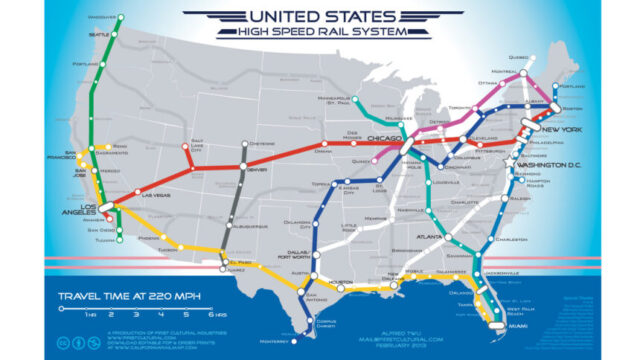Is the US Finally on Track to Build a High-Speed Rail Network?
The United States, with a population of over 340 million and an extensive network of 71 interstate highways and more than 5,000 public airports, currently lacks high-speed train systems. However, recent developments signal that the country might be gearing up to match the rapid train networks of nations like China, Japan, and those in Europe.
Progress in High-Speed Rail Construction
Two significant high-speed rail (HSR) projects are currently under construction: the line connecting San Francisco and Los Angeles, and another between Las Vegas and Los Angeles. Rick Harnish from the High Speed Rail Alliance highlights the unique challenges posed by California’s terrain for the first route, while viewing the Las Vegas leg as more achievable due to its flat landscape.
Moreover, plans are underway for a new HSR line stretching from Portland, Oregon, to Seattle, Washington, and extending into Vancouver, Canada. A connection between Dallas and Houston is also in the works, though recent federal funding cuts have cast doubt on the Texas project.
Comparative Analysis of Global HSR Networks
As the US endeavors to develop its first high-speed rail systems, the scale of HSR networks abroad serves as a stark contrast. China’s HSR network is set to exceed 50,000 kilometers (31,000 miles) this year, while the European Union boasts a total of 8,556 kilometers led by Spain’s 3,190 kilometers. The only high-speed route currently operational in the UK is High Speed 1, connecting London to the Channel Tunnel, with High Speed 2 under construction despite funding issues.
Challenges Facing US HSR Implementation
Despite the ambitious plans, Harnish cautions that progress is sluggish, especially for the proposed Portland-Seattle line, and the future of the Texas connection appears uncertain after the withdrawal of a $63.9 million federal grant during the previous administration. Amtrak, the government-owned passenger service, does not currently operate any high-speed trains, although they are introducing 28 new 160 mph NextGen Acela trains on the Northeast Corridor this year.
The new trains will operate on a limited segment of the existing track, where only about 50 miles out of 457 miles can accommodate speeds over 150 mph. Complicating matters further, Amtrak’s leader, Stephen Gardner, resigned amidst reports of pressure from the White House.
Global Perspectives on HSR Expansion
Globally, HSR is already operational in 23 nations. In contrast, US cities face hurdles in integrating HSR into densely built environments. According to Scott Sherin from French train manufacturer Alstom, the political willingness to fund rail transport instead of other infrastructure remains a significant barrier.
Potential for International Collaboration
Looking ahead, there is hope that collaboration with Chinese firms could lead to advancements in US rail infrastructure, although significant political difficulties persist. Will Doig, an author and rail journalist, emphasizes the lack of appetite for change among the American populace, who often prioritize car travel and local grievances over nationwide rail initiatives.
| Country | HSR Length (km) |
|---|---|
| China | 50,000+ |
| European Union | 8,556 |
| Spain | 3,190 |
| United States (current) | 0 |
In summary, while the US is making tentative steps towards establishing high-speed rail systems, significant cultural and political shifts will be essential for a successful implementation. As international partners look to develop rail networks, the US must evaluate its infrastructure priorities to benefit from the potential economic uplift seen in other countries.














